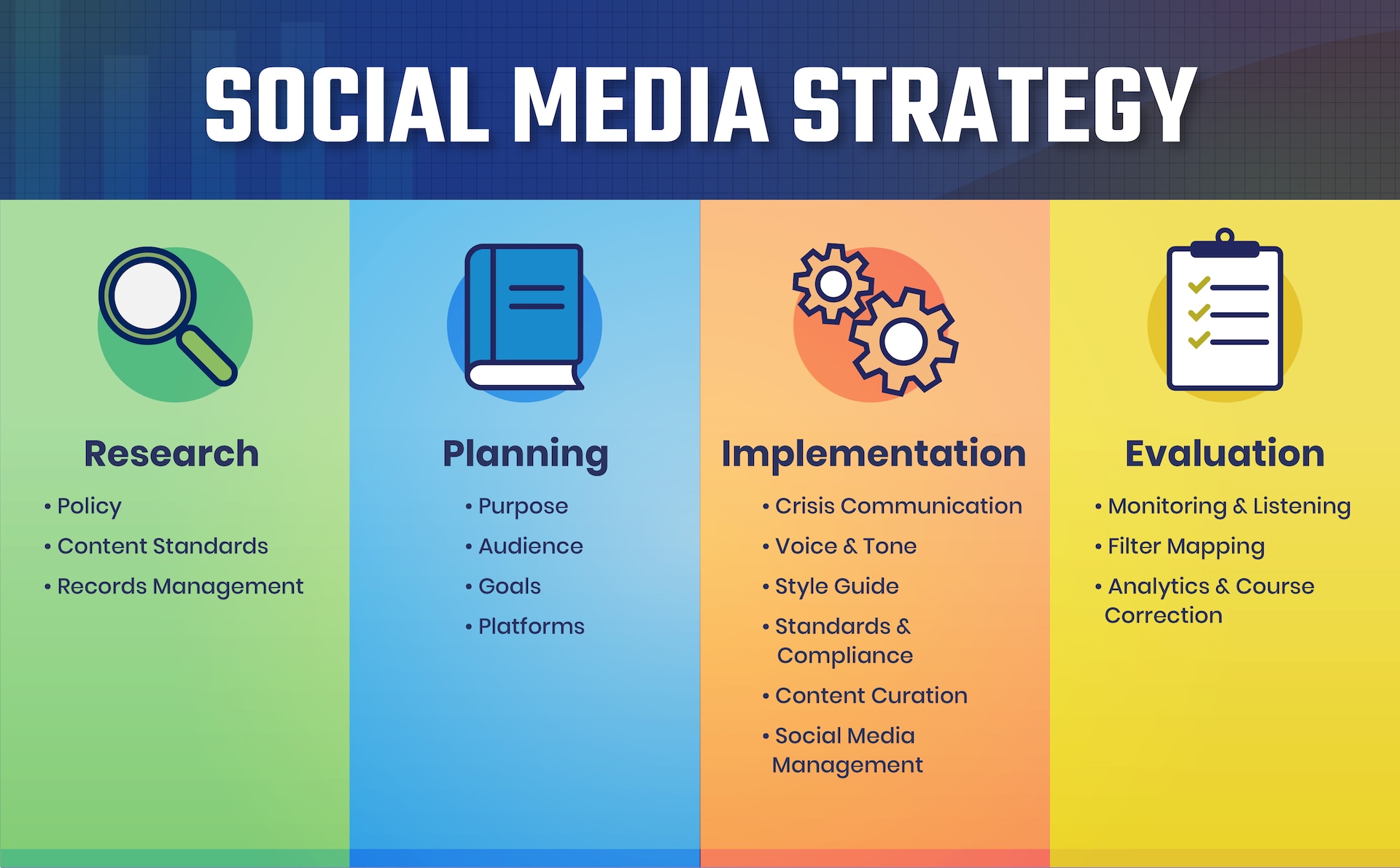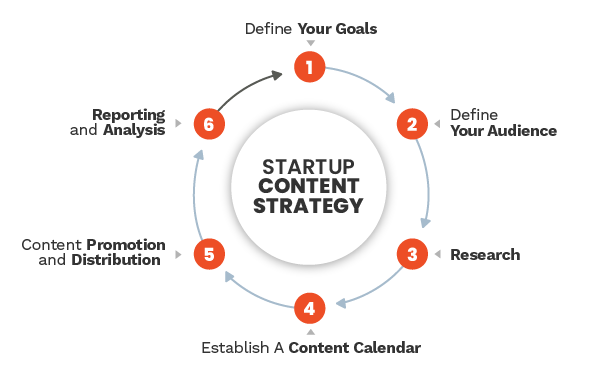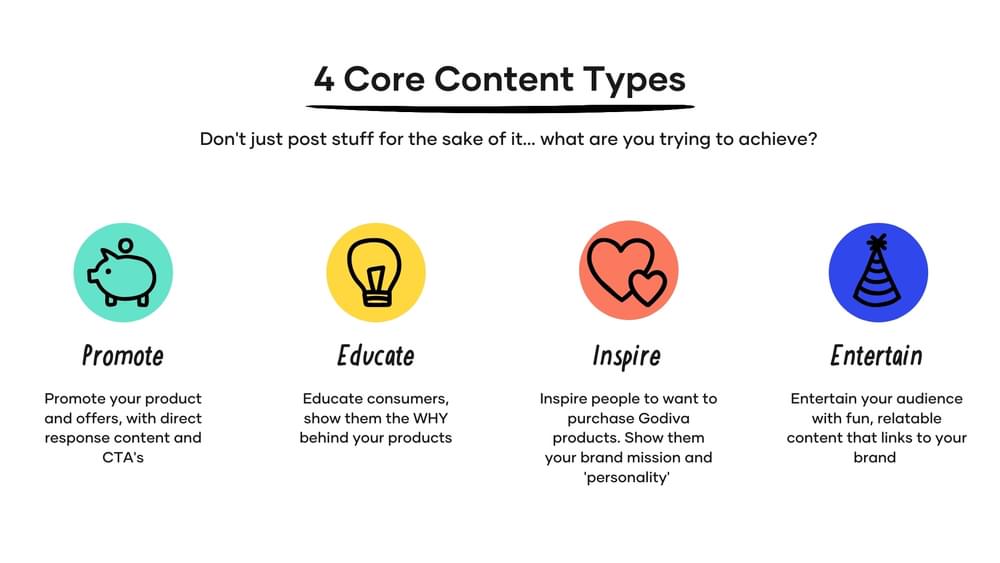A Social Media Content Strategy outlines a plan for creating, posting, and managing content on social media platforms. It aims to engage the audience, build brand awareness, and drive traffic.
Crafting a successful Social Media Content Strategy involves understanding your target audience, setting clear goals, and selecting the right platforms. Start by researching your audience’s preferences and behaviors to tailor content that resonates with them. Define measurable goals like increasing engagement, driving website traffic, or boosting conversions.
Choose platforms where your audience is most active and create a content calendar to maintain consistency. Use a mix of content types such as text, images, and videos to keep the audience engaged. Regularly analyze performance metrics to refine your strategy and achieve better results.
Introduction To Social Media Strategy
Social media is a powerful tool for businesses today. Without a clear strategy, efforts can be wasted. A well-planned strategy helps reach the right audience and achieve goals.
Importance Of Strategy
A strong social media strategy ensures that content aligns with business goals. It helps in targeting the right audience with the right message. This increases engagement and builds brand loyalty.
Consistency is another key benefit. With a strategy, posting schedules become regular. This keeps followers engaged and helps in maintaining a steady presence.
A strategy also aids in tracking performance. By analyzing data, adjustments can be made to improve results. This ensures that efforts are not in vain.
Current Trends
Staying updated with trends is vital. Currently, video content dominates social media. Short, engaging videos attract more views and shares.
Influencer marketing is also on the rise. Collaborating with influencers can boost credibility and reach. This is especially effective on platforms like Instagram and TikTok.
User-generated content is gaining traction. Encouraging followers to create and share their own content increases engagement. It also builds a sense of community around the brand.
Interactive content, like polls and quizzes, is very popular. It encourages active participation and keeps the audience engaged. This type of content is effective on platforms like Facebook and Twitter.
Defining Your Goals
Creating a social media content strategy starts with defining your goals. Knowing your goals helps focus your efforts. This way, you ensure your content brings value and achieves desired results.
Setting Objectives
Set clear and specific objectives for your social media content. Objectives guide your efforts and keep your strategy on track.
- Increase Brand Awareness: Aim to reach more people and make your brand known.
- Boost Engagement: Encourage likes, comments, and shares on your posts.
- Generate Leads: Use content to attract potential customers.
- Drive Traffic: Direct users to your website or landing pages.
Measuring Success
Measuring success is crucial to understand if your strategy is working. Use key performance indicators (KPIs) to track progress.
| Objective | KPI |
|---|---|
| Increase Brand Awareness | Number of followers, reach, and impressions |
| Boost Engagement | Likes, comments, shares, and post interactions |
| Generate Leads | Number of sign-ups, inquiries, and conversions |
| Drive Traffic | Click-through rates (CTR) and website visits |
Understanding Your Audience
Creating a strong social media content strategy starts with understanding your audience. Knowing who they are, what they like, and how they behave online helps you create content that resonates.
Identifying Demographics
Identifying demographics is crucial. This involves understanding your audience’s:
- Age
- Gender
- Location
- Income Level
- Education Level
Use tools like Google Analytics and Facebook Insights. These tools help gather demographic data.
Analyzing Behavior
Analyzing behavior involves looking at:
- What time they are online
- What type of content they engage with
- Which platforms they prefer
Here is a simple table to understand their behavior:
| Behavior | Details |
|---|---|
| Online Time | Morning, Afternoon, Evening |
| Content Type | Videos, Images, Articles |
| Preferred Platform | Facebook, Instagram, Twitter |
Use this data to tailor your content strategy. This ensures your content is relevant and engaging.

Credit: www.searchenginejournal.com
Content Creation
Creating engaging social media content requires a well-thought-out strategy. It involves understanding your audience, knowing your goals, and crafting content that resonates. Let’s dive into how to excel in Content Creation for social media.
Types Of Content
Different types of content can keep your audience engaged. Here are some popular options:
- Images: High-quality photos attract more attention.
- Videos: Short videos can go viral easily.
- Infographics: These make complex information easy to understand.
- Stories: Temporary content that creates urgency.
- Polls and Quizzes: Interactive content that boosts engagement.
Content Calendar
A content calendar helps you plan and organize your posts. Here’s how to create one:
| Day | Content Type | Topic | Platform |
|---|---|---|---|
| Monday | Image | Motivational Quote | |
| Tuesday | Video | Product Demo | |
| Wednesday | Infographic | Industry Stats | |
| Thursday | Poll | Customer Feedback | |
| Friday | Story | Behind-the-Scenes |
Using a content calendar ensures consistency in your social media presence. It helps you avoid last-minute rushes and keeps your content varied and interesting.
Leveraging Visuals
Visuals play a crucial role in social media content strategy. They capture attention, convey messages quickly, and engage your audience effectively. Using the right visuals can significantly boost your social media presence and enhance user engagement. Let’s dive into the importance of visuals and some design tips to optimize your content.
Importance Of Visuals
Visual content is more likely to be shared and remembered. People process images faster than text. This makes visuals essential for quick communication. Here are some reasons why visuals are important:
- Increased Engagement: Posts with images get more likes and shares.
- Enhanced Retention: Visuals help people remember your message longer.
- Stronger Emotional Connection: Images evoke emotions that text alone can’t.
- Brand Identity: Consistent visuals help build a recognizable brand.
Design Tips
Creating effective visuals requires attention to design elements. Here are some tips:
- Use High-Quality Images: Ensure your images are clear and professional.
- Consistency: Use a consistent color scheme and style.
- Text Overlay: Add text to images to highlight key points.
- Branding: Incorporate your logo and brand colors in visuals.
- Simple Design: Keep your design clean and uncluttered.
Following these design tips can make your visuals more appealing. High-quality and consistent visuals help to strengthen your brand identity. Simple and clean designs ensure your message is clear and effective.
Engagement Tactics
Engagement Tactics are essential for a successful social media content strategy. These tactics help you connect with your audience. They also boost your content’s visibility and interaction rates. By using specific engagement tactics, you can foster a loyal community and encourage users to participate actively.
Interactive Content
Interactive content is a great way to engage your audience. It includes quizzes, polls, and surveys. These formats prompt users to respond, increasing engagement.
Use quizzes to create fun and educational experiences. For example, “Which Movie Character Are You?” or “How Well Do You Know Our Brand?”.
Polls are quick and easy ways to get feedback. Ask questions like, “Which product should we launch next?” or “What’s your favorite feature?”.
With surveys, dive deeper into user preferences. Offer incentives like discounts for completing them.
Community Building
Community building helps create a loyal follower base. Engage with your audience regularly to foster this community.
Create a Facebook Group or a Subreddit for your brand. This space allows users to connect and share their experiences.
Host live sessions on platforms like Instagram or Facebook Live. During these sessions, answer questions, share updates, and interact with your audience in real-time.
Encourage user-generated content (UGC). Ask your followers to share their photos or stories using your products. Feature the best ones on your social media pages.
| Engagement Tactic | Description |
|---|---|
| Quizzes | Fun, educational experiences prompting user responses. |
| Polls | Quick feedback method with simple questions. |
| Surveys | In-depth insights into user preferences. |
| Facebook Groups | Spaces for users to connect and share experiences. |
| Live Sessions | Real-time interaction with followers. |
| User-Generated Content | Encouraging followers to share their experiences. |
Utilizing Analytics
Utilizing Analytics is crucial in shaping an effective social media content strategy. Analytics provide a wealth of data about your audience’s behavior. This data helps refine your approach to achieve better results. By understanding the numbers, you can create content that resonates with your audience.
Tracking Metrics
Tracking metrics is vital for understanding your social media performance. Key metrics to monitor include:
- Engagement Rate: Measures how users interact with your content.
- Reach: The total number of unique users who see your content.
- Impressions: The number of times your content is displayed.
- Click-Through Rate (CTR): Percentage of users who click on your links.
- Conversion Rate: Percentage of users who complete a desired action.
Use these metrics to gauge what content works best. For example, a high engagement rate indicates content that resonates well with your audience.
Optimizing Strategy
After tracking metrics, the next step is optimizing your strategy. Here are some steps:
- Analyze Data: Look at the metrics to find patterns and trends.
- Set Goals: Use the insights to set realistic and measurable goals.
- A/B Testing: Test different content types to see what works best.
- Adjust Content: Modify your content based on what the data reveals.
- Monitor Results: Keep an eye on the metrics to see if changes are effective.
Optimizing ensures your content remains relevant and engaging. It helps in achieving better ROI from your social media efforts.
Here’s a simple table to summarize key actions:
| Action | Description |
|---|---|
| Analyze Data | Review metrics for patterns and trends. |
| Set Goals | Establish measurable and realistic objectives. |
| A/B Testing | Experiment with different content types. |
| Adjust Content | Modify based on data insights. |
| Monitor Results | Track the effectiveness of changes. |
By following these steps, your social media strategy will continually improve. This leads to higher engagement and better overall performance.

Credit: pavilion.dinfos.edu
Paid Promotions
Paid promotions on social media can dramatically boost your brand’s visibility. They provide a way to reach a larger audience quickly. Understanding ad types and budgeting can maximize your returns.
Ad Types
There are several types of social media ads. Each type serves different purposes.
- Photo Ads: Ideal for showcasing products visually.
- Video Ads: Great for storytelling and engagement.
- Carousel Ads: Feature multiple images or videos in one ad.
- Slideshow Ads: Use motion to create lightweight videos.
- Collection Ads: Allow users to browse products directly in the ad.
Budgeting Tips
Effective budgeting ensures your paid promotions are cost-efficient.
- Set Clear Goals: Define what you want to achieve with your ads.
- Start Small: Test different ad types with a small budget first.
- Monitor Performance: Keep track of how each ad is performing.
- Adjust Accordingly: Reallocate budget to high-performing ads.
- Utilize Analytics: Use data to refine your strategy.
Here’s a table summarizing the key points:
| Ad Type | Purpose |
|---|---|
| Photo Ads | Showcase products visually |
| Video Ads | Storytelling and engagement |
| Carousel Ads | Multiple images or videos in one ad |
| Slideshow Ads | Create lightweight videos |
| Collection Ads | Browse products directly in the ad |
By understanding ad types and budgeting wisely, you can make the most of paid promotions.
Collaborations And Partnerships
Collaborations and partnerships can elevate your social media strategy. Working with other brands or influencers can expand your reach. This section explores how to leverage these opportunities.
Influencer Marketing
Influencer marketing involves partnering with social media personalities. Influencers have loyal followers who trust their opinions. This makes influencer marketing highly effective.
Choose influencers whose audience aligns with your target market. This ensures your message reaches the right people. Use the following steps for a successful influencer campaign:
- Identify suitable influencers in your niche.
- Analyze their engagement rates and audience demographics.
- Reach out with a personalized collaboration proposal.
- Track and measure the campaign’s performance.
Brand Partnerships
Brand partnerships involve collaborating with other companies. This can mutually benefit both brands. Joint campaigns can double your audience and resources.
Consider these tips for effective brand partnerships:
- Find brands with similar values and audience.
- Propose a win-win collaboration idea.
- Plan and execute the campaign together.
- Evaluate the results and share insights.
| Type of Partnership | Key Benefit |
|---|---|
| Influencer Marketing | Higher engagement and trust |
| Brand Partnerships | Expanded reach and resources |
Future Trends
The landscape of social media is ever-changing. Keeping up with future trends can help you stay ahead of the curve. Let’s explore the emerging platforms and innovative techniques shaping the future of social media content strategy.
Emerging Platforms
New social media platforms are continually emerging. These platforms offer unique features and user experiences. Understanding these new platforms can give your content a competitive edge.
- Clubhouse: An audio-based platform. Users engage in real-time conversations.
- Vero: Focuses on authenticity. No ads and no algorithms.
- TikTok: Short, engaging videos. Perfect for creative content.
These platforms cater to different types of content. It’s essential to tailor your strategy for each.
Innovative Techniques
New techniques are constantly evolving in social media marketing. These techniques can boost engagement and reach.
| Technique | Description |
|---|---|
| Interactive Content | Polls, quizzes, and interactive stories. They engage users actively. |
| AR Filters | Augmented reality filters. Users can overlay digital content on real-world images. |
| Live Streaming | Real-time interaction with followers. Builds a direct connection. |
Incorporating these techniques can make your content stand out. They create more engaging and immersive experiences for users.

Credit: www.frac.tl
Frequently Asked Questions
What Is A Social Media Content Strategy?
A social media content strategy is a plan. It outlines what content to post, when, and where. This helps achieve marketing goals effectively.
How Do I Create Engaging Content?
Understand your audience’s interests first. Then, create relevant, high-quality posts. Use visuals, videos, and interactive elements.
Why Is Consistency Important In Social Media?
Consistency builds trust and keeps your audience engaged. Regular posts ensure your brand stays top-of-mind. It also improves your algorithm performance.
What Tools Help In Planning Content?
Tools like Hootsuite, Buffer, and Trello are useful. They help schedule posts, track performance, and organize content efficiently.
Conclusion
Crafting a strong social media content strategy is essential for success. Tailor your content to your audience’s preferences. Use analytics to refine your approach. Consistency and engagement build trust and loyalty. Follow these steps to elevate your social media presence and achieve your business goals.
Start today and see the difference.
